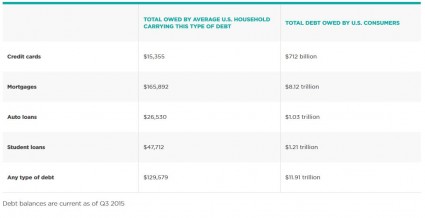December 28, 2015
By: Bobby Casey, GWP Managing Director
 Looking back at nearly 100 articles in 2015, we’ve done our level best to keep you guys informed. There are a good number of glitzy distractions, and it can be difficult to stay focused much less find the real news that matters.
Looking back at nearly 100 articles in 2015, we’ve done our level best to keep you guys informed. There are a good number of glitzy distractions, and it can be difficult to stay focused much less find the real news that matters.
But when I look back over 2015, I see a horrible trend. I see MORE government, not less. And where there is more government, there is more strife, more regulations, more spending, more violence, more taxes, and more struggles for the common man.
So what about 2016?
Let’s first take inventory of what sort of baggage we’re toting into next year:
- Suspended debt ceiling for the WHOLE year!
- Debt. Lots and lots of debt.
- The first hike in interest rates from the Fed in years.
- First US commonwealth defaults on its debts (Puerto Rico)
- China’s renminbi graduating to reserve currency
- The EU is in some thick water
I don’t know about the New Year being “fresh start”. The reality is, January 1st is no different than August 12th. What’s August 12th? Just another day like January 1st. With that said, how will these things affect one another?
#1, A suspended debt ceiling for an entire year? Expect to hit the $20 Trillion national debt mark before the end of 2016. I expect to get there by Q4, but I it’s the holidays, so I’ll be slightly lenient. But what does it matter? It’s just some inconceivable number anyway right? No. It matters. It matters because of #6. China isn’t buying up US treasuries as it once was. It’s selling them off. It sold off US treasuries to support the yuan, and will continue to dump our debt as long as it suits them. Well if the biggest customer of US debt isn’t buying, how are we going to keep printing? The debt means something when you have no one to buy it up anymore.
#2 and #3 is like a 7 year old’s chemistry set: expect that to be explosive. Janet Yellen feels so confident in the USD she decided to hike the interest rates for the first time in years. Granted, it’s was only a couple basis points, but still it makes saving less of a liability. #2 however puts a bit of a damper on #3. If you’re not about debt, then great! But national debt aside, the US has a ridiculous amount of individual and revolving debt. (Source: Nerdwallet.com)
“The latest statistics from the Federal Reserve indicate consumer debt in the United States continues to increase, reaching nearly $3.4 trillion in May 2015. According to statistics published by the Census Bureau, that works out to over $10,200 in debt for every man, woman and child that lives here in the United States.
“Anyone thinking that statistic isn’t alarming needs to keep this in mind: the $10,600 per person doesn’t include debt associated with mortgages.” (Source: Money-zine.com)
Consumer confidence and practicality are not aligned well. People trying to save up for a home are faced with hiking interest rates. People trying to save for retirement aren’t getting a return. People are told that the economy has improved, so they spend more, but the overall economic outlook is largely propped up by unsound, and therefore unsustainable, economics.
For now, unemployment is below where it was when Bush left office, which is good reason for people to feel hopeful. Taxes and regulations are high, cost of living is high, and if we continue to march toward a higher minimum wage (ostensibly to offset our deflated dollar) then our economy will likely stagnate or enter into a state of stagflation.
The precarious trapeze act of meeting economic demands through various forms of debt is not sustainable at all – neither nationally nor individually.
Finally, the quivering states who have all but fallen to their knees. Despite dropping energy prices and their efforts at Quantitative Easing (QE), their “recovery” can at best be considered sluggish. They aren’t in freefall, so that’s good. But their expected growth is low, and the staggering unemployment rates among some of the member states poses a threat. In their interactive infographic, The Economist shows the numbers for all the member states of the EU. Check out Spain, Portugal, and Italy in particular.
| Country | GDP/Person | Unemployment | Youth Unemp. | Debt % GDP | GDP Change |
| Italy | 27,000 Euro | 11% | 41% | >100% | +0.75% |
| Portugal | 17,000 Euro | 12% | 32% | >100% | +1.25% |
| Spain | 22,000 Euro | 22% | 48% | >100% | +3.5% |
It’s not looking good for these guys. It’s like a race to the bottom, and a chain is only as strong as its weakest link. The EU, overall, is experiencing a net positive economic condition right now. Any of these three countries losing their footing could have serious implications for the entire union.
Look at their fellow bailout country, Ireland when juxtaposed with Britain:
| Country | GDP/Person | Unemployment | Youth Unemp. | Debt % GDP | GDP Change |
| Ireland | 41,000 Euro | 9% | 21% | 80%-99% | +7.3% |
| Britain | 35,000 Pounds | 6% | 15% | 80%-99% | +2.3% |
Ireland is holding its own and is expected to maintain that trajectory. By no means has this been easy for them, but Italy, Spain, and Portugal would do well to take a few pages from Ireland’s playbook. Low taxes and austerity aren’t just right wing talking points. They are the opposite actions of what go them into their current mess in the first place.
I don’t think that consumer confidence is going to be enough for the US next year. I think China is going to find a way to rebound, the alliance between Russia and China will fortify, and we might very well be talking about a second rate USD come this time next year. With the endless wars and mounting debt, regulatory and tax burdens, and the trend in capital flight, no economist can honestly think the 2016 outlook is anything more than superficially bright.
I like to see what other people think when they look ahead into 2016. Some are saying the dollar is strong. The realist in me has to ask, “Relative to what?” Compared to the dollar in 1912, it’s totally worthless. When compared to the price of silver it’s still worthless. When compared with the price of gold the blank paper in my printer has more worth. But when compared to other crippled currencies around the world, ours still has one working crutch?
Looking at the pool of competition, I wouldn’t exactly be eager to put all my stock in the USD. In fact, rather than look at the global standing of one country pitted against another, it would be more prudent to look at the economic and political integrity of each of those countries on their own. Imagine yourself trying to buy property in Detroit. If all houses are dilapidated, does it matter that some of them still have door frames? Not really. The house is still dilapidated, door frames notwithstanding.
More than anything, keep a very hawkish eye on the regulatory landscape; not just taxes, but the IRS’ functions and capital controls overall; and travel restrictions. All three will take on new heights in the coming year in the name of safety, responsibility, and fairness. These are bipartisan bugaboos, so no matter who assumes the thrown in next year’s election, all three of those things will get worse before they get any better.
Have a safe and happy New Year! Here’s wishing you and yours every success in life, business, and freedom!


